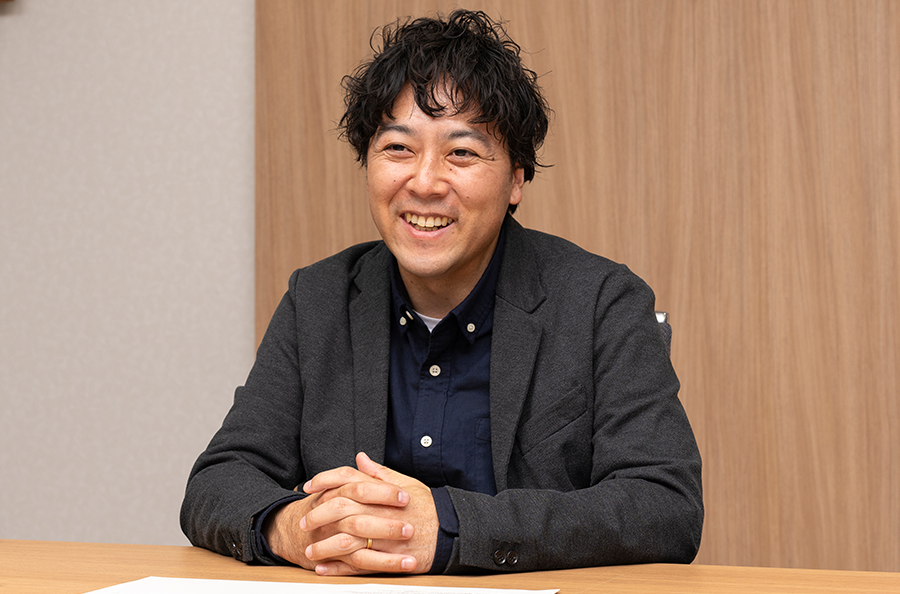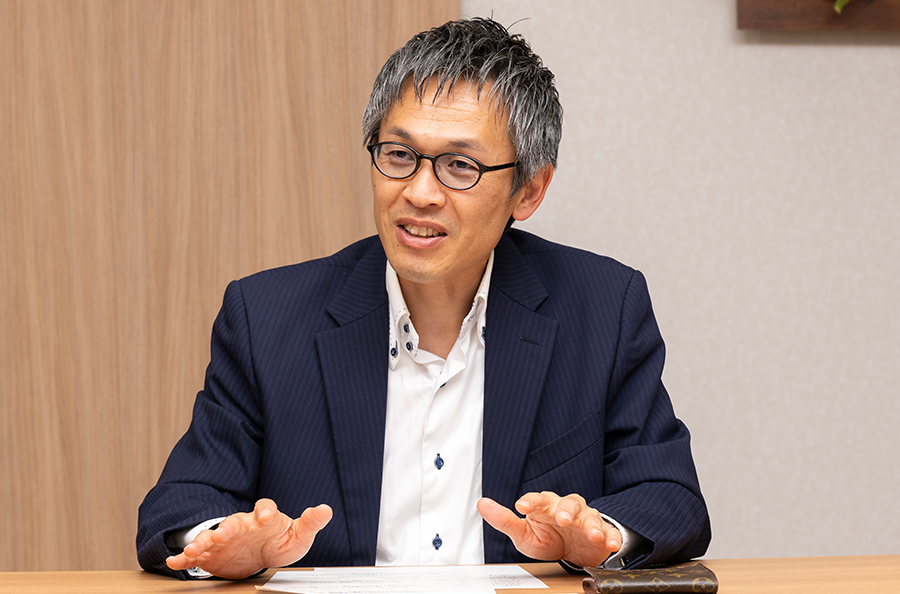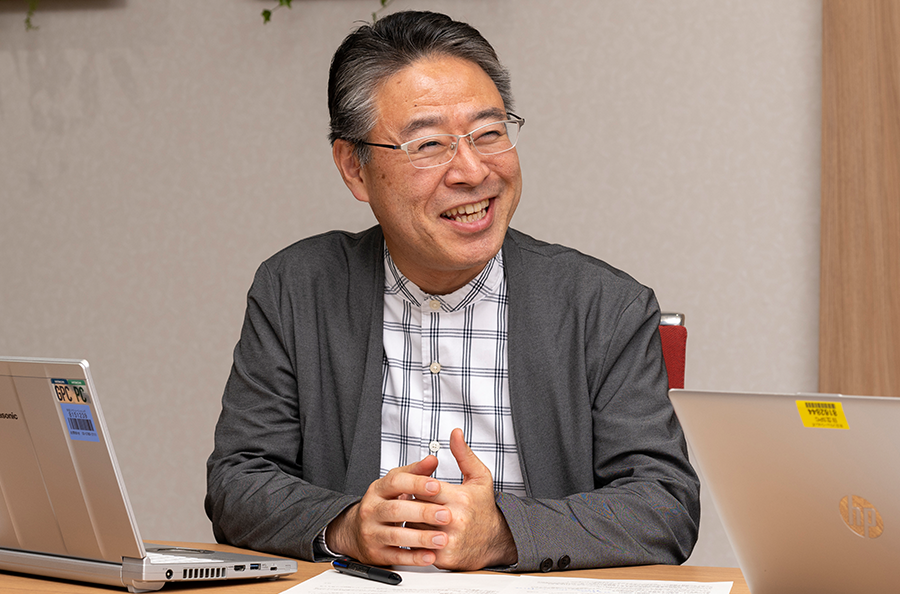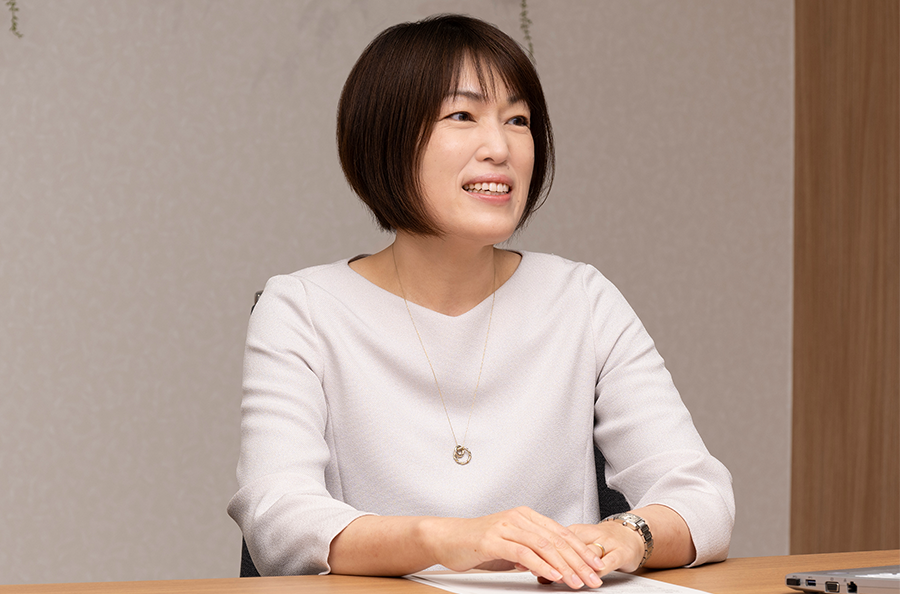Report
LYSITHEA: An Integrated HR Solution that Enhances EX
Amidst the social problems of long working hours and a shrinking workforce, the consequence of an aging population and falling birthrate, Japan has embarked on a transition towards becoming a society where everyone has the flexibility to choose how they want to work. This transition includes the introduction of a series of measures known as the Related Acts to Promote Work Style Reform, which began in April 2019. Meanwhile, working practices are becoming more varied in response to factors such as greater awareness of diversity and the growing acceptance of remote working prompted by the COVID-19 pandemic. At the same time, however, issues are also emerging with employee engagement and an increase in the number of people resigning from their jobs prematurely. These considerations are making HR departments more important than ever to corporate activity.
In addition to its in-house efforts to improve its own HR systems, Hitachi Solutions, Ltd. has also responded to these working practice trends by launching new services as part of its long-running LYSITHEA series of integrated HR solutions. Here, Hitachi Review speaks to key people about the HR department activities that served as the basis for these new services, and about their features and deployment.
Amidst an accelerating pace of change in working practices and the workplace environment, Hitachi Solutions, Ltd. has put a lot of effort into creating environments that are amenable to the people working in them, including by being an early adopter of human resources (HR) technology for making HR better and more efficient. Shinichi Koyama, Senior HR Tech Specialist at the Human Capital & General Affairs Group, has participated not only in in-house improvement efforts, but also in supporting HR reforms by clients. He makes the point that the challenges facing HR and HR strategy over recent years come from an awareness of how these interact with business strategy.
“Faced with an increasingly harsh environment, companies are looking to their HR policies to make a greater contribution to the business. Hitachi Solutions is currently putting a lot of effort into achieving sustainable management and into the collaborative creation of societal value in partnership with customers and other stakeholders. This makes it important that we expand human networks both within the company and further afield and create a flexible organization that encourages ambition and ideas among our workforce. Accordingly, inspired by our vision for what sort of business we want to be, we are pursuing bottom-up HR policies that underpin these goals.”
 Shinichi Koyama
Shinichi Koyama
Senior HR Tech Specialist, Human Capital & General Affairs Group
Hitachi Solutions, Ltd.
Hitachi Solutions has since 2016 consolidated its different HR policies under the banner of “working style reform,” pursing initiatives with goals that have included reducing overtime hours and minimizing instances of ill health. With the spread of COVID-19 and the accompanying “new normal,” this has also been augmented by practices that give employees a degree of flexibility in choosing how they work. Despite these efforts, employee surveys have found that, while “ease of working” has improved, “motivation” has failed to do so, especially among younger employees. In response, an initiative launched in April 2022 to improve employee experience (EX)*1 set out to give every employee in the company’s diverse workforce a sense of motivation and growth. In practice, this involved support for employees making their own choices about their careers and what challenges to take on. Examples include a system for establishing startups whereby the company supports independent initiatives, and a job matching system that gives younger employees discretion over their choice of job.
As Shinichi Koyama explains, “The attitude in our HR department is that if you have an idea, you should try it in practice before considering it further. Instead of delving into things too deeply at the planning stage, with the end result that nothing actually gets done, the idea is to try it for real and then get feedback from the workforce to identify the issues and benefits, pressing ahead with those initiatives that show promise and abandoning those that don’t. By going through this cycle quickly, we have been able to build up know-how. When systems and solutions that have been developed for external customers are compatible with our own policies, another common practice is to use them for ourselves and provide feedback to the operational divisions on any issues that arise in doing so.”
 Fumitoshi Ogura
Fumitoshi Ogura
Department Manager, HR Solution Development Department, Smart Work Solution Division, Smart Life Solution Business Division
Hitachi Solutions, Ltd.
Employee engagement is an important factor in motivation, including the enthusiasm that employees have for their work and how positive they feel about their workplace. It is also an indicator of how many employees have a sense of agency and enthusiasm for their work. Fumitoshi Ogura, Department Manager of the HR Solution Development Department, Smart Work Solution Division, Smart Life Solution Business Division, makes the case that improving EX boosts employee engagement, and that it also has a positive impact on sustainable management, productivity, and profitability.
“There is academic evidence that a positive attitude of feeling glad to be working for your company enhances performance when promoting or delivering the company’s products and services to customers. This proposition that improved EX leads to improved customer experience (CX) is not just something out of theoretical management strategy. We have seen this effect for ourselves.”
According to the State of the Global Workplace: 2023 Report published by the US company Gallup, Inc. in June 2023, only 5% of Japanese employees had a high level of employee engagement in 2022, placing the country alongside Italy at the bottom of the 145 countries surveyed. The work being done at Hitachi Solutions, meanwhile, has attracted attention after the company recorded the highest level of employee engagement in the Hitachi Group in a 2022 survey.
 Jun Hirayama
Jun Hirayama
Group Manager, HR Solution Development Department, Smart Work Solution Division, Smart Life Solution Business Division
Hitachi Solutions, Ltd.
As it works to improve experience value for employees, Hitachi Solutions has been supplying the LYSITHEA integrated HR solution since 1994. This solution provides comprehensive support for the HR activities of its corporate customers. To date (as of March 2023), the solution has been adopted by more than 1,630 companies. Jun Hirayama, Group Manager at the HR Solution Development Department, Smart Work Solution Division, Smart Life Solution Business Division, had the following to say about it.
“LYSITHEA started out as a system developed in response to customer requests to automate time and attendance accounting. Initially in close competition with the products of other vendors, it went on to acquire an increasing number of corporate users following its transition to a web-based system and the provision of features such as mechanisms for tracking working hours by project.”
Comprised initially of services that support core corporate activities, combining HR and payroll along with time and attendance accounting, LYSITHEA has subsequently been augmented with additional people-focused services.
As Jun Hirayama puts it, “When the process of merging multiple companies to establish what is now Hitachi Solutions made it difficult to keep track of the careers and skills of individual employees, we created in-house systems for centralizing HR data and making it available to help with training and with assigning people to roles. It was a precursor of what we now call a talent management system and it worked so well that we made it part of the LYSITHEA series. Whereas HR systems in the early days were considered adequate if they could calculate employee payroll correctly, the demand in recent years has been to support proactive HR that works in tandem with business strategy. We have also added extra services that contribute to a broad range of HR operations.”
LYSITHEA currently has a lineup of 13 services. These include LYSITHEA/Employee Engagement, LYSITHEA/Women's Empowerment Service, and LYSITHEA/Talent Matching, three new services launched in 2022 with the aims of energizing employees and creating an environment in which a diverse workforce can thrive, thereby resolving corporate challenges and delivering sustainable growth in the form of sustainable management and EX improvement (see Figure 1).
Figure 1—Services Available from LYSITHEA Integrated HR Solution HR: human resources
HR: human resources
While employee engagement is seen as having a positive impact on business performance, many companies are still feeling their way when it comes to measures for making improvements. In response, Hitachi Solutions has set out to identify the issues by creating opportunities to consult with the LYSITHEA user base.
Jun Hirayama commented on this, saying that, “One of the things we learned from these consultations is that measures for improving employee engagement do not last if they are led and administered by the company based on traditional top-down management. Improving engagement on a sustained basis requires self-management practices whereby the employees themselves work through a cycle of identifying the issues, devising ways of addressing them, and putting them into practice to make improvements. Accordingly, we developed a service for doing this through joint research with Professor Akihito Shimazu of the Faculty of Policy Management at Keio University, the leading figure in the field of work engagement.”
LYSITHEA/Employee Engagement has individual employees identify their work-related issues and then formulate and implement action plans for making improvements, with the level of achievement then being assessed by their team. It seeks to sustain these initiatives by publicizing individual employee activities and by rewarding and encouraging them (see Figure 2).
 Mutsuko Murai
Mutsuko Murai
Group Manager, HR Solution Development Department, Smart Work Solution Division, Smart Life Solution Business Division
Hitachi Solutions, Ltd.
Creating workplace environments that are more amenable to women, such as increasing the proportion of women in management, is essential to improving corporate sustainability. LYSITHEA/Women's Empowerment Service underpins empowerment by providing health support for women. What prompted its development was a 2020 report compiled by a Hitachi Solutions research team in the USA.
Fumitoshi Ogura had the following to say, “The report covered topics such as the growing interest in the USA in femcare*2 and femtech*3 and the specific support measures that companies are providing for their female employees. Given that this is an area where increased demand is anticipated in Japan also, we set about investigating how we could also provide such services. To do this, we had our employees make use of an in-house health consultation service for women that was being provided on a trial basis by a medical institution. While this was a simple service that gave participants the opportunity to talk to a nurse or midwife about any concerns they had about their bodies, the very positive feedback from user questionnaires led to our decision to commercialize it.”
While the primary focus of the service is currently on health consultations, the plan is to also provide learning materials to boost understanding among both men and women about the issues specific to the female body and the importance of addressing them. Ultimately, the goal is to expand the service into one that lives up to its name of supporting the empowerment of women, including things like career support.
As Fumitoshi Ogura commented, “Advancing understanding by male managers of issues specific to women should make work easier for their female subordinates and colleagues. The improved performance of women should be positive for the organization as a whole.”
As a woman, Mutsuko Murai, Group Manager at the HR Solution Development Department, Smart Work Solution Division, Smart Life Solution Business Division, also expressed high hopes for the service.
“The reality is that women have had few opportunities in the past to learn about their own bodies and it can often be difficult for us to talk about these things among ourselves given that physical health issues can vary widely between individuals. As the LYSITHEA/Women's Empowerment Service provides the opportunity to have a proper talk with a nurse, midwife, or other health expert, even when you are still unsure whether a problem is something you should have checked out at a hospital. I see it as a means of improving psychological safety and personal health literacy.”
LYSITHEA/Talent Matching (see Figure 3) came about as a result of an HR initiative introduced by Hitachi Solutions in 2020 called the “Professional Elder Program.” The program enables employees who have reached the retirement age of 60 to continue working to age 65 based on a renewable annual employment contract, giving them a choice of whether to stay in their existing department, to make their employment history and skills available for scouting by other workplaces, or to apply for in-house positions open to employees of retirement age. It was the system developed to implement this program that became the basis for talent matching in LYSITHEA. Hitachi Solutions went on to use this system for other programs. In addition to an in-house free agent (FA) system and internal recruitment, this included a job matching program for junior staff whereby graduate recruits in their third year at the company can choose whether to continue in their existing department or apply for other in-house positions.
Jun Hirayama explained by saying, “Creating an environment where people are able to do work that interests them and where they can put their skills to use is essential to improving ease of working and motivation. Given the interest in job-based employment (in contrast to the membership-based approach common in Japan), we recognized the need for practices that can optimize how companies match employees to jobs and so began offering this system to external customers.”
The work of serving as an intermediary is complex and burdensome for HR departments, including tasks such as identifying and collating people’s experience and skills from large amounts of HR data and, without compromising security, using this information for in-house recruiting or to match individuals with suitable work and then verifying their own wishes and handling the transfer procedures. The ability to introduce a matching system that computerizes this sequence of steps and thereby avoids increasing the HR department workload should bring considerable benefits.
Shinichi Koyama added that, “While I expect other measures also provided synergistic benefits, the talent matching system has brought a sustained reduction in the rate of people leaving the company. One notable outcome is how the matching system for junior staff has not only made our workforce more dynamic, it has, I believe, also made people more conscious of their work by prompting them to give serious thought to what exactly they want to do at the company.”
Fumitoshi Ogura commented that, “Programs such as the company’s FA system give managers cause to think more deeply about how they can make their departments more attractive. I also suspect that having a degree of workplace turnover can energize an organization and create a virtuous circle, invigorating it at a company-wide level.”
The feedback from employees who have made use of the job matching system has been positive, with comments such as, “The job matching system for junior employees provided me with a challenge by allowing me to find work I want to do,” and “While getting a job somewhere else was an option, the way the company FA system matched me with my desired department led me to stay on.”
Mutsuko Murai likewise made the point that, “There is much about work that you cannot appreciate until you are actually doing it. While a particular job may not suit you, having the opportunity to work in a different field while staying with the company should improve employee engagement and employee retention.”
These new services have received a lot of interest from other companies, with ongoing progress toward their adoption. In the case of talent matching, for example, additional functions are being added to enable the system to be utilized not only by the corporate client itself, but also across the other companies and organizations in the corporate group to which it belongs. Meanwhile, whereas the benefits of talent matching are visible in improved workforce retention, demonstrating the benefits of support for women's empowerment or employee engagement is more difficult and this poses a problem.
Fumitoshi Ogura addressed the issue by saying, “Despite this, there are many in the corporate world who understand that both measures are needed for organizational revitalization. As many aspects of ease of working defy quantification, I believe it is vital that we adopt an attitude of getting alongside customers to ask what can be done to facilitate the growth of employees and of the company.”
Mutsuko Murai added, “As the new LYSITHEA services involve proposing the adoption of activities or programs that did not exist in the past, they are not something that can be accomplished simply by the installation of an information technology (IT) tool. At Hitachi Solutions, we draw on the operational expertise and knowledge of our own HR practices to propose HR programs that in some cases include cultural reform, doing our best to get customers to appreciate the value they offer.”
Born out of customer requirements for time and attendance accounting, LYSITHEA has over time contributed to advances in the field of HR. Its strengths lie in functions and services that address workplace feedback and customer challenges, and in the meticulous way in which it is marketed and implemented.
Mutsuko Murai also commented that, “As the LYSITHEA series has been in use for such a long time, consultations with customers keep us informed about their current challenges and about new measures they are considering. This is reflected in product enhancements and new developments. Even when standard package functions do not satisfy specific customer requirements, rather than relying on add-ons or customization, there have also been cases where we have drawn on past knowledge and expertise to suggest ways in which the customer can modify their program design or operational practices, and where they have recognized how this has improved efficiency.”
Another feature of LYSITHEA is how the operational flexibility of its product functions provide resilience amidst changing circumstances. At a time when practices such as telework, flextime, and part-time work are making working practices more diverse, LYSITHEA has had the flexibility to adapt simply by modifying parameter settings rather than by making changes to the product itself, even when new employment practices are introduced or changes made to work rules or HR systems.
Fumitoshi Ogura said, “The goal with LYSITHEA is to provide people in the corporate sector with total support that encompasses the three areas of core HR activities (HR, payroll, and employment management), workforce strategy (talent management and so on), and EX and other forms of employee wellbeing. We aim to be a solution that utilizes HR data to help enrich the lives of all employees and get them feeling energized in their work.”
Paying close attention to the diversity of individual employees and extracting maximum value is at the core of enhancing corporate value. While remaining true to the origins of its LYSITHEA integrated HR solution, Hitachi Solutions intends to add new value as it seeks to energize both the corporate sector and wider society.